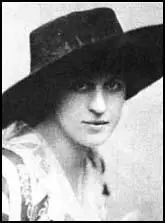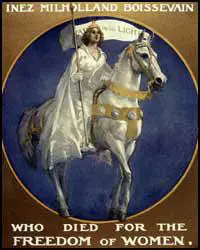Inez Milholland

Inez Milholland was born in Brooklyn on 6th August, 1886. She attended Vassar College and was suspended after organizing a women's suffrage meeting in a cemetery.
After her graduation in 1909 she traveled in Europe before she settled in Greenwich Village and was associated with a group of socialists involved in the production of The Masses journal. This included Max Eastman, John Reed, Floyd Dell, Crystal Eastman, Louis Untermeyer, William Walling, Art Young, Michael Gold, Boardman Robinson, Robert Minor, Randolph Bourne, Dorothy Day, Mabel Dodge, Mary Heaton Vorse and Louise Bryant.
On 3rd March 1913 Milholland led the women's suffrage demonstration in Washington on a white horse. Wearing white robes, the photograph of Milholland during the parade became one of the most memorable images of the struggle for women's rights in America. After one demonstration Milholland was said to be the "most beautiful woman ever to bite a policeman's wrist."
Inez was introduced to Boissevain by Max Eastman. Boissevain was a businessman who made his fortune by importing coffee beans from Java. A friend, Alyse Powers, argued that he was "handsome, reckless, mettlesome as a stallion breathing the first morning air, he would laugh at himself, indeed laugh at everything, with a laugh that scattered melancholy as the wind scatters the petals of the fading poppy...He had the gift of the aristocrat and could adapt himself to all circumstances ... his blood was testy, adventurous, quixotic, and he faced life as an eagle faces its flight." In July 1913 the couple were married.
Milholland, like most of the people associated with The Masses, believed that the First World War had been caused by the imperialist competitive system and that the USA should remain neutral. This was reflected in the fact that the articles and cartoons that appeared in journal attacked the behaviour of both sides in the conflict. In December, 1915, Milholland and other pacifists travelled on Henry Ford's Peace Ship to Europe.

On her return to the United States she became one of the leaders of the National Women's Party. The movement's most popular orator, Milholland was in demand as a speaker at public meetings all over the country. Milholland, who suffered from pernicious anemia, and was warned by her doctor of the dangers of vigorous campaigning. However, she refused to heed this advice and on 22nd October, 1916, she collapsed in the middle of a speech in Los Angeles. She was rushed to hospital but despite repeated blood transfusions she died on 25th November, 1916.
After her death the women's movement helped create the image of a martyr. A popular poster stated: "Inez Milholland Boissevain: Who Died for the Freedom of Women."
Primary Sources
(1) Floyd Dell wrote about Inez Milholland in his autobiography, Homecoming (1933)
Inez Milholland had been her (Edna St. Vincent Millay) heroine in college days; that militant leader of the struggle for women's freedom had been suspended in shocked disapproval from Vassar, but had since then become its pride and boast.
(2) Alice Paul, letter to Heywood Broun after an article he published on Inez Milholland (26th August, 1924)
I have read your statement that the Woman's Party "did not want a Negro to speak at the grave of Inez Milholland" and am writing to give you the facts.
The pilgrimage to the grave of Inez Milholland was organized by the Woman's Party. It consisted almost entirely of Woman's Party members who had worked with Inez in the suffrage fight, although we also invited her family and friends to accompany us. We arranged a very simple ceremony of music and singing, and, at the urgent request of a member of Inez's family we arranged to have no speakers at the grave.
Shortly before the service began, Mr. Milholland, the father of Inez, told us that he had invited Mr. Scott a distinguished Negro, to speak at the grave. We explained to Mr. Scott that there were to be no speeches at the grave and asked if he would place a wreath as the rest of us were doing, instead of making a speech. To this suggestion he immediately acceded.
After we had placed our wreaths and the choir was leading the procession down the hillside, Mr. Milholland called upon Mr. Scott and Mrs. Hunton, secretary of the Association for the Advancement of Negroes, to speak. The Woman's Party members listened with courtesy to these two speakers and at the conclusion expressed appreciation to them of what they had said. These two Negroes were the only speakers at the grave.
At this point I want to make clear that these two speakers did not intentionally break into our service. They came to the pilgrimage, we understand, under the impression that it had been organized by the Milholland family, that speeches were to be made at the grave dealing with various political, social and economic movements with which Inez had been connected and that they were to represent upon this occasion the movement for the advancement of Negroes. As soon as they learned that the memorial at the grave was a Woman's Party memorial, that it was to commemorate the service of Inez in the suffrage cause, and that there were to be no speakers, they fell in with these plans and would not have spoken had they not been publicly called upon to do so.
I would like, before concluding, to take up two statements which you make. You write: "They did not want a Negro to speak at the grave of Inez Milholland, because, as Mrs. Greta Wold Boyer explained, We want to try and elect some congressmen in Southern States." This statement was not made by Mrs. Boyer and could not have been made because we are not trying to elect congressmen in any Southern State.
You attribute the following statement to me: "This was arranged as a demonstration of women and it was no place for colored people to speak." With regard to colored people as speakers, we arranged as I have already said, to have no speakers, and the question of color of speakers was never discussed by us.
The Woman's Party is made up of women of all races, creeds and nationalities who are united on the one program of working to raise the status of women. In our organization there is absolutely no discrimination with regard to race, creed or nationality. If we had planned to have speakers on this occasion, the question of their race would not have been considered in selecting them.
We are sorry that this controversy has arisen over our effort to honor one of our fellow-workers. I think that all the women of the Woman's Party who went upon this pilgrimage did so with the single desire of expressing their affection for Inez. They had no thought of political effect or expediency in what they were doing and greatly regret that the effort has been made to use this pilgrimage against the interest of the woman's cause to which Inez gave her life.
